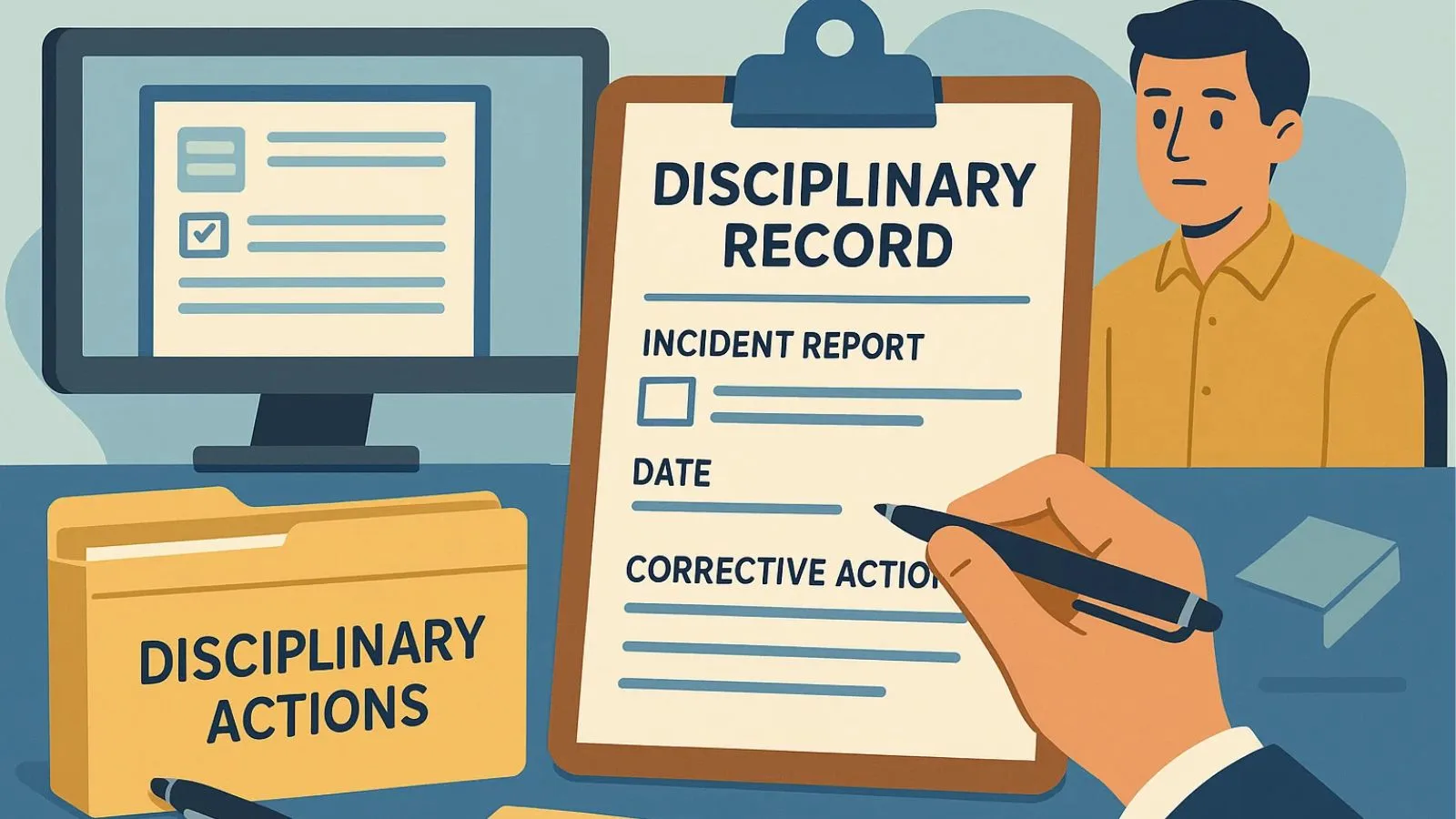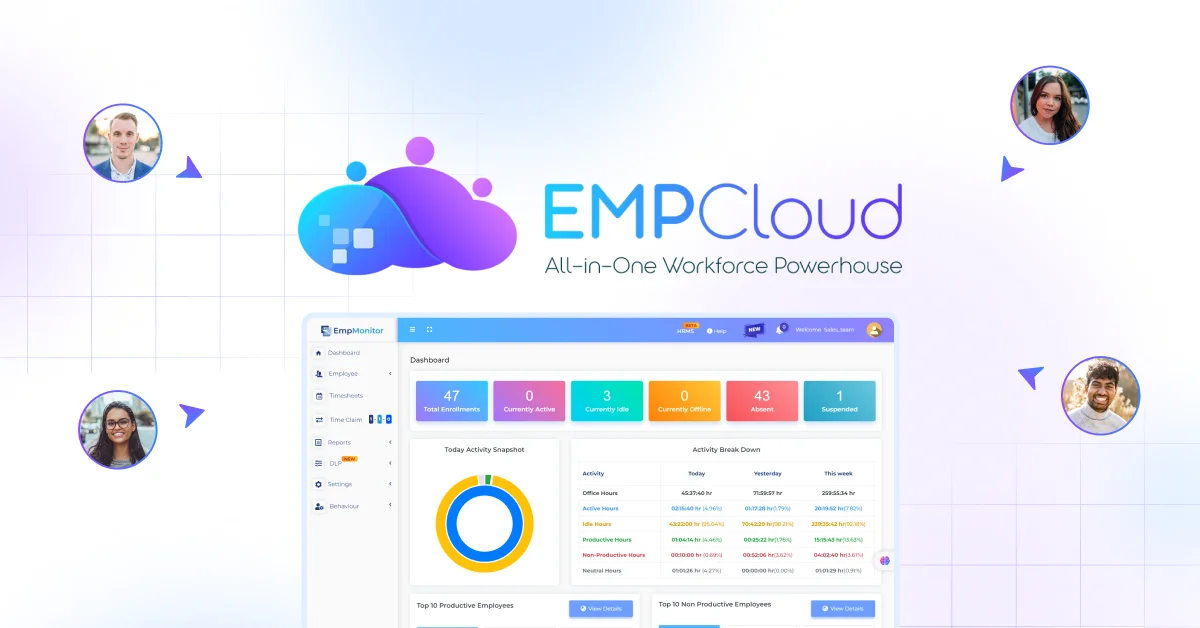
A disciplinary infraction in the workplace is any violation of company policies, procedures, or behavioral standards that can result in formal corrective action.
Whether you’re an employee concerned about your job security or a manager responsible for maintaining workplace standards, understanding what constitutes a disciplinary infraction is essential for navigating today’s professional environment.
In this comprehensive guide, we’ll explore the various types of disciplinary infractions, how organizations handle them, and what rights you have when facing workplace discipline.
Listen Podcast Now!
Understanding Disciplinary Infractions:
It’s any action, behavior, or failure to act that violates your employer’s established rules and expectations.
Every organization maintains standards to ensure productivity, safety, and a positive work environment. A Fair And Transparent Attendance Policy, for instance, helps set clear expectations about punctuality and presence, reducing misunderstandings and ensuring consistency in how attendance-related infractions are handled.
When employees breach these standards, employers typically respond with progressive discipline, starting with warnings and potentially escalating to suspension or termination.
A disciplinary infraction doesn’t always mean immediate termination. Most companies follow a structured approach to handle violations, recognizing that people make mistakes.
The severity of a disciplinary infraction depends on several factors, including the nature of the offense, whether it’s a first-time violation, and the potential impact on the organization.
Common Disciplinary Infraction Examples:
Understanding real-world scenarios helps clarify what might constitute a disciplinary infraction in your workplace. Here are typical examples you might encounter:
1. Performance-Related Issues:
Consistently missing deadlines, failing to meet quality standards, or producing substandard work can result in a disciplinary infraction.
Managers typically document these issues and work with employees to improve performance before escalating to formal discipline.
- Attendance Problems:
Unexcused absences, chronic tardiness, or abuse of sick leave represent common disciplinary violations.
Most companies establish clear attendance policies, and repeated violations can trigger formal corrective action.
3. Policy Violations:
Breaking company policies regarding dress code, social media usage, confidentiality agreements, or technology use can lead to a disciplinary infraction. These policies exist to protect both the company and employees.
4. Conduct Issues:
Unprofessional behavior, insubordination, conflicts with colleagues, or creating a hostile work environment are serious forms of disciplinary infractions that require immediate attention.
5. Safety Violations:
Ignoring safety procedures or OSHA regulations creates liability for employers and can result in immediate disciplinary action or termination, depending on severity.
6. Financial Misconduct:
Fraudulent expense reports, theft, or mishandling of company funds constitute serious disciplinary infractions with potentially criminal implications.
Minor Infraction vs. Serious Violations:
Not all breaches of workplace rules carry the same weight. A minor infraction might be addressed informally with a verbal warning, while more serious violations demand documented disciplinary action.
Understanding this distinction helps you gauge the appropriate response to workplace issues.
A minor infraction typically involves first-time, unintentional violations with minimal impact on operations.
Examples include arriving late occasionally, forgetting to follow a specific procedure, or a single policy oversight.
Managers usually address these through coaching or informal discussions rather than formal discipline.
In contrast, serious disciplinary violations involve intentional misconduct, repeated offenses, safety concerns, or actions that significantly impact the business.
These situations warrant formal documentation and structured disciplinary processes that may include written warnings, suspension, or termination.
The difference between a minor and serious violation often lies in intent, frequency, and consequence.
HR departments assess whether the act was deliberate or accidental, whether it has occurred before, and how it affects the organization’s integrity or reputation.
For example, sharing confidential data, engaging in workplace harassment, or falsifying records are categorized as serious violations regardless of prior history.
Establishing clear definitions in the company handbook helps ensure fairness and consistency in disciplinary decisions across all levels of the organization.
The Progressive Discipline Approach:
Most organizations use progressive discipline when addressing a disciplinary infraction. This approach recognizes that employees deserve opportunities to correct their behavior before facing severe consequences.
Verbal Warning:
The first step typically involves a manager discussing the issue with the employee. This informal conversation documents the problem and clarifies expectations. Many minor infractions never progress beyond this stage.
Written Warning:
If behavior continues, a formal written warning becomes part of the employee’s personnel file. This document specifies the violation, expected improvements, and consequences of future infractions.
Suspension:
Some disciplinary infractions warrant temporary suspension, during which employees are sent home without pay. This signals serious concern about the behavior and serves as a final opportunity to demonstrate improvement.
Termination:
When a disciplinary infraction remains unaddressed after previous interventions or when the initial violation is severe enough to warrant immediate dismissal, employment may be terminated.
Progressive discipline is not a “one-size-fits-all” model. Some organizations use performance improvement plans (PIPs) for extended observation, offering structured timelines for correction.
This approach builds accountability and demonstrates the employer’s intent to rehabilitate rather than penalize.
Moreover, a consistent, well-documented discipline policy reduces bias, protects against legal challenges, and maintains fairness across teams.
Documentation: Why It Matters?
Proper documentation of every disciplinary infraction protects both employers and employees.
When a manager records the specific incident, the date, involved parties, and agreed-upon corrective actions, it creates an objective record that can be referenced later.
This documentation becomes crucial if an employee contests the discipline or if legal issues arise.
Documentation also helps HR teams identify patterns of behavior that may indicate underlying problems, like training needs, poor management communication, or gaps in policy enforcement.
For employers, maintaining accurate records ensures compliance with employment laws and provides legal protection if disputes escalate to arbitration or litigation.
As an employee, you have the right to know about any disciplinary infraction recorded in your file.
You can typically request to review your personnel file and may have the opportunity to respond to documented violations.
Keeping your own records of discussions or performance reviews can also help you defend your position if you believe discipline was unjustified.
Your Rights During Disciplinary Action:
When facing a disciplinary infraction, you have several important rights. Most jurisdictions require employers to provide reasonable notice and an opportunity to respond to allegations before implementing discipline.
You may have the right to union representation or to have a witness present during disciplinary meetings.
Employers must also respect confidentiality, ensuring that disciplinary discussions remain private and limited to those who need to know.
In addition, you are protected from retaliation for engaging in legally protected activities, such as reporting harassment, safety concerns, or discrimination.
Employers cannot use disciplinary action as a disguise for punishing employees who raise valid complaints.
If you believe your disciplinary action is unfair, you can appeal the decision through your company’s grievance process or, in severe cases, file a complaint with a labor board or legal counsel.
Understanding these rights empowers you to navigate disciplinary situations confidently and ensures your employer follows fair, lawful procedures.
Preventing Disciplinary Infractions:
The best strategy is prevention. Familiarize yourself with your company’s employee handbook and policies.
Attend training sessions and maintain open communication with your manager about expectations and concerns. When you’re unsure about a policy, ask for clarification rather than guessing.
Employees who take initiative to understand expectations are far less likely to face disciplinary action.
Proactive behaviors such as seeking feedback, documenting communications, and demonstrating accountability show professionalism and help prevent misunderstandings that could lead to discipline.
Similarly, managers play a vital role in prevention. They can minimize disciplinary infractions by setting clear performance goals, offering consistent coaching, and recognizing achievements alongside addressing issues.
Building a transparent, respectful environment where employees feel supported encourages compliance and reduces workplace conflict.
Also Read:
How To Formulate A Fair And Transparent Attendance Policy
Malicious Compliance: Understanding The Hidden Workplace Challenge
Streamline Workplace Management with EmpCloud:
Handling disciplinary infractions becomes effortless with EmpCloud, an integrated HR platform designed to simplify employee management from onboarding to offboarding.
EmpCloud automates every stage of the disciplinary process, ensuring consistency, compliance, and transparency across your organization.
With EmpCloud’s advanced case management module, HR professionals can log incidents in real-time, attach evidence or supporting documentation, and instantly notify relevant parties.
The platform tracks employee progress through each stage of the discipline process, allowing managers to monitor behavioral improvements and follow-up actions.
Additional EmpCloud features include:
- Recruitment & Onboarding: Simplify hiring and onboarding for faster, smoother team integration and reduced administrative workload.
- EmpMonitor: Track employee productivity and performance with real-time insights that help managers make informed decisions.
- HRMS: Manage attendance, leave, compliance, and essential documentation in one centralized platform for optimal efficiency.
- Field Force Management: Efficiently manage and monitor field operations, ensuring accountability and productivity across remote teams.
- Payroll Management: Automate payroll processing, tax management, and compliance to ensure accurate and timely employee payouts.
- Biometrics: Strengthen employee security and eliminate attendance fraud with seamless biometric verification systems.
- Project Management: Coordinate projects with complete visibility, track progress, and enhance collaboration between teams.
- Rewards & Recognition: Recognize and reward top performers to boost motivation, engagement, and retention.
- Performance & Career Management: Continuously monitor performance and support career development with structured evaluation frameworks.
- Exit & Portfolio Management: Simplify exit formalities and manage background verification portfolios efficiently, ensuring a smooth offboarding process.
By automating repetitive HR tasks, EmpCloud saves time, reduces administrative burden, and promotes fair, data-driven decision-making.
The centralized dashboard gives executives and HR leaders complete visibility into workplace trends, enabling faster resolutions and improved compliance across departments.
EmpCloud doesn’t just manage infractions; it helps create a culture of accountability, transparency, and continuous improvement.
Streamline your HR operations and ensure fair, compliant disciplinary practices today.
Conclusion:
Navigating disciplinary infractions requires understanding company policies, your rights, and the proper procedures your employer should follow.
Whether facing discipline yourself or responsible for implementing it, knowledge is your best tool.
A well-informed workforce is a stable and productive one. When employees clearly understand expectations and organizations enforce policies consistently, everyone benefits.
Companies maintain compliance and harmony, while employees feel secure knowing disciplinary systems are transparent and fair.
The key is communication and fairness; discipline should never feel like punishment but an opportunity for improvement.
Managers should focus on correcting behavior, not assigning blame. Employees, in turn, should view feedback constructively and take steps to improve performance.
By maintaining professional standards, addressing issues promptly, and leveraging tools like EmpCloud, organizations can build trust, minimize conflicts, and promote long-term growth.
Remember: the ultimate goal of discipline is not punishment, it’s progress and the preservation of a healthy workplace culture.
FAQ’s:
Q1: Can I be fired for a first disciplinary infraction?
Ans: Generally, no. Most companies follow progressive discipline for minor violations. However, serious misconduct like theft, harassment, or safety violations may result in immediate termination. It’s also important to review your employee handbook, some roles, particularly those involving confidential information or safety-sensitive duties, may have stricter disciplinary terms. Employers must still ensure that the process follows due procedure and aligns with labor laws.
Q2: What should I do if I disagree with a disciplinary action?
Ans: Review your company’s appeal process. Document your perspective, request a meeting with HR, and follow the established procedures outlined in your employee handbook. Maintain professionalism during discussions and avoid emotional reactions. You can also submit a written statement to be added to your personnel file. If internal resolution fails, consider consulting legal counsel or a labor authority for further guidance.
Q3: Can I refuse to sign a disciplinary document?
Ans: You cannot prevent documentation, but your signature typically indicates you’ve received and read the document, not necessarily that you agree with it. You can request to add a note clarifying your disagreement or attach a written rebuttal to your file. Refusing to sign doesn’t invalidate the action, but adding your written response ensures your version of events is officially recorded.
Q4: How long does a disciplinary infraction stay on my record?
Ans: Most companies keep disciplinary records for a specific period, often six months to two years, depending on the infraction’s severity and internal policy. After this time, minor infractions may be removed from your record or become inactive. However, repeated offenses can extend that period. Always ask HR about your organization’s retention policy for disciplinary documents.
Q5: Can disciplinary actions affect my promotion or pay raise?
Ans: Yes, they can. While one minor infraction may not have long-term consequences, multiple or serious disciplinary issues can impact promotion eligibility, salary increments, or bonus considerations. Employers often review performance and conduct a history check before approving career advancements. Demonstrating consistent improvement after a violation can help rebuild trust and restore opportunities.










